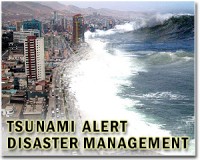| . |  |
. |
Paris (AFP) Aug 18, 2010 A tsunami that hit the Pacific islands of Samoa and Tonga last year was generated by three earthquakes unleashed by a seismic mechanism that has never been observed before, scientists said on Wednesday. The September 29, 2009 disaster killed 186 people in Samoa, American Samoa and northern Tonga when waves rearing as high as 15 metres (49 feet) flattened villages and resorts. Seismologists initially pinned the blame on a massive quake of magnitude 8.0, later upgraded to 8.1, occurring 18 kilometres (11.2 miles) below the sea on the Tonga Trench. But within weeks, doubt soon set in, as a single quake could not explain the pattern of tsunami waves and their height variations. Reporting Wednesday in the British journal Nature, US experts said they found the 8.1 temblor unleashed two more extremely powerful quakes in very quick succession. Each measured 7.8 magnitude and occurred close to each other, at a location more than 50 kilometres (31 miles) from the initial event. "When we looked at the data, it turned out it wasn't just one great earthquake but three large earthquakes that happened within two minutes of one another," said Keith Koper, director of the University of Utah Seismograph Stations. "The two quakes that were hidden by the first quake ended up being responsible for some of the damage and tsunami waves." That one quake can cause another quake is not in itself new. "Domino" quakes are notorious, for instance, on the Sunda Trench off the Indonesian island of Sumatra and on Turkey's North Anatolian Fault. But what happened at the Tonga Trench occurred among distinctly different types of faults, with implications for understanding how tsunamis are caused, the researchers said. The Tongan Trench lies at the conjunction of the Pacific plate and a microplate called the Tongan block. Pushing westwards, the Pacific plate collides with the Tongan block before diving beneath it, a movement called subduction. The plates are moving towards other at 20 centimetres (12 inches) a year, the fastest of any such convergence in the world. But the motion has been historically smooth, and the previous 8.0-plus quake in this area was in 1917. Scientists were thus deeply surprised when the 2009 disaster happened. The sleuths found that the 8.1 quake occurred when part of the Pacific plate broke apart close to the entrance where that plate dives beneath the Tongan block. In seismological terms, this is called a "normal-faulting" quake, meaning that the ground is pulled apart along the fault. Shaking from the 8.1 quake then triggered the nearly simultaneous 7.8 quakes in the subduction zone, where the Pacific plate was already far beneath the Tongan block. Quakes that occur in subduction zones are called "thrust" quakes, in which the seabed is moved up or down or up by the release of pent-up stress. The finding is significant, for this is the first time that a normal-faulting quakes has been found to cause a large thrust quake on a plate boundary. "We didn't realise these thrust earthquakes could be triggered by a normal earthquake," said Koper. "We've had seismometers only 100 years, and good observations only the last 50 years, so not enough earthquake cycles have been observed to see this before." The multiple quake "is unusual and almost certainly increased the size of the tsunami and its destructiveness on some Tongan islands," said GNS Science, a New Zealand geophysics agency which contributed to a second paper in Nature. The latter study used a different technique to distinguish between the 8.0 and subsequent quakes, notably using Global Position System (GPS) monitors, and says it cannot be sure about which quake occurred first. "When I processed the data and looked at the GPS results, I was astonished to see that the (Tongan) island of Niuatoputapu had moved nearly 400mm (15 and a half inches) east," said John Beavan of GNS. Beavan's team said the second event was a single quake of 7.9 magnitude. In contrast, Koper said seismic signals showed there had been a double jolt, comprising two quakes measuring 7.8 and occurring very close together in space and time. The first 7.8 quake occurred between 49 and 89 seconds after the 8.1 quake, said Koper. The second 7.8 quake began 90 to 130 seconds after the 8.1 event.
Share This Article With Planet Earth
Related Links Bringing Order To A World Of Disasters When the Earth Quakes A world of storm and tempest
 NASA demos tsunami prediction system
NASA demos tsunami prediction systemPasadena, Calif. (UPI) Jun 14, 2010 A NASA-led research team says it has successfully demonstrated for the first time elements of a prototype tsunami prediction system. Scientists at NASA's Jet Propulsion Laboratory, which manages the system, say it can quickly and accurately assesses large earthquakes and estimate the size of a resulting tsunami. After February's magnitude 8.8 Chilean earthquake, a JPL team led by ... read more |
|
| The content herein, unless otherwise known to be public domain, are Copyright 1995-2010 - SpaceDaily. AFP and UPI Wire Stories are copyright Agence France-Presse and United Press International. ESA Portal Reports are copyright European Space Agency. All NASA sourced material is public domain. Additional copyrights may apply in whole or part to other bona fide parties. Advertising does not imply endorsement,agreement or approval of any opinions, statements or information provided by SpaceDaily on any Web page published or hosted by SpaceDaily. Privacy Statement |